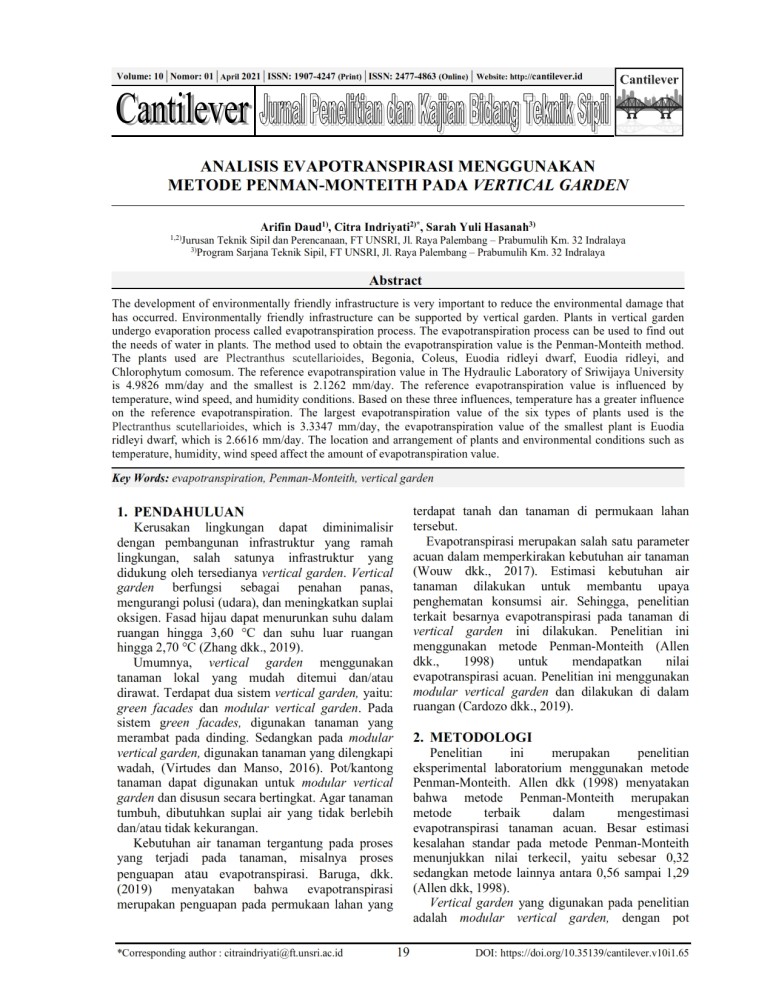Analisis Evapotranspirasi Menggunakan Metode Penman-Monteith pada Vertical Garden Evapotranspiration Analysis Using the Penman-Monteith Method in a Vertical Garden
Main Article Content
Abstract
The development of environmentally friendly infrastructure is very important to reduce the environmental damage that has occurred. Environmentally friendly infrastructure can be supported by vertical garden. Plants in vertical garden undergo evaporation process called evapotranspiration process. The evapotranspiration process can be used to find out the needs of water in plants. The method used to obtain the evapotranspiration value is the Penman-Monteith method. The plants used are Plectranthus scutellarioides, Begonia, Coleus, Euodia ridleyi dwarf, Euodia ridleyi, and Chlorophytum comosum. The reference evapotranspiration value in The Hydraulic Laboratory of Sriwijaya University is 4.9826 mm/day and the smallest is 2.1262 mm/day. The reference evapotranspiration value is influenced by temperature, wind speed, and humidity conditions. Based on these three influences, temperature has a greater influence on the reference evapotranspiration. The largest evapotranspiration value of the six types of plants used is the Plectranthus scutellarioides, which is 3.3347 mm/day, the evapotranspiration value of the smallest plant is Euodia ridleyi dwarf, which is 2.6616 mm/day. The location and arrangement of plants and environmental conditions such as temperature, humidity, wind speed affect the amount of evapotranspiration value.
Downloads
Article Details
Baruga, C.K., Kim, D., & Hoi, M. (2019). A National-Scale
Drought Assessment in Uganda Based on Evapotranspiration Deficits from Bouchet Hypothesis. Journal of Hydrology 580, 1-44.
Cardozo, D. A. S., Sinobas, L. R., & Zubelzu, S. (2019). Living Green Walls: Estimation of Water Requirements and Assessment of Irrigation Management. Urban Forestry & Urban Greening 46 , 1-9.
Putranto, D. A. dkk. (2020). Pengukukuran BM Referensi UNSRI dan Penentuan Batas Desa dalam Peningkatan Status Hak Atas Tanah Masyarakat Desa Kembahang 2, Kecamatan Pemulutan, Kabupaten Ogan Ilir. Palembang: Jurusan Teknik Sipil dan Perencanaan Universitas Sriwijaya.
SNI 7745:2012. (2012). Tata Cara Perhitungan Evapotranspirasi Tanaman Acuan dengan Metode Penman-Monteith. Bandung: Badan Standarisasi Nasional.
Virtudes, A. & Manso, M. ( 2016). Applications of Green Walls in Urban Design. Earth and Environmental Science 44, 1-6.
Wouw P. M. F., Ros, E. J. M., & Brouwers, H. J. H. (2017). Precipitation Collection and Evapo(transpi)ration of Living Wall Systems. Building and Environment 126, 221-237.
Zhang, L., Deng, Z., Liang, L., Zhang, Y., Meng, Q., Wang, J., & Santamouri, M. (2019). Thermal Behaviour of a Vertical Green Façade and its Impact on the Indoor and Outdoor Thermal Environment. Energy & Buildings, 204. https://doi.org/10.1016/j.enbuild.2019.109502

This work is licensed under a Creative Commons Attribution-NonCommercial 4.0 International License.
Authors who publish with this journal agree to the following terms:
- Authors retain copyright and grant the journal right of first publication with the work simultaneously licensed under a Creative Commons Attribution-NonCommercial 4.0 International License that allows others to share the work with an acknowledgment of the work's authorship and initial publication in this journal.
- Authors are able to enter into separate, additional contractual arrangements for the non-exclusive distribution of the journal's published version of the work (e.g., post it to an institutional repository or publish it in a book), with an acknowledgment of its initial publication in this journal.
- Authors are permitted and encouraged to post their work online (e.g., in institutional repositories or on their website) prior to and during the submission process, as it can lead to productive exchanges, as well as earlier and greater citation of published work (See The Effect of Open Access).
